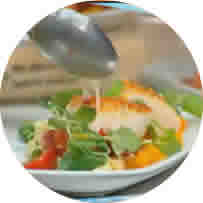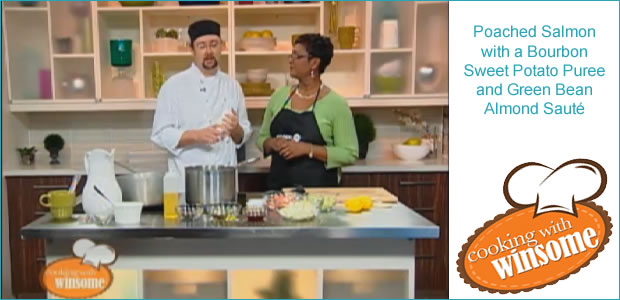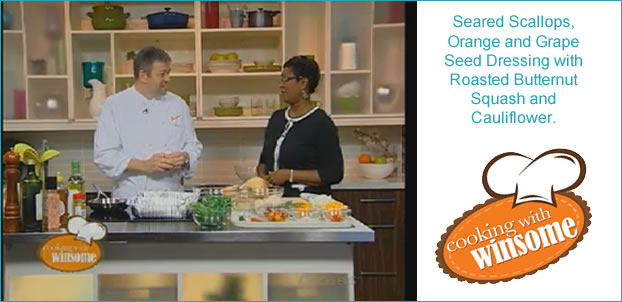 Gluten Free Chocolate Raspberry Cake
Gluten Free Chocolate Raspberry Cake
Today I am with Franz Hochholdinger Owner and Operator of Apricot Tree Café and Bistro Narra preparing a delicious Gluten Free Chocolate Raspberry Cake
[threecol_two]
- 175g Semi Sweet Chocolate
- 125 g Butter
- 6 Eggs
- 100 g Sugar
- Melt chocolate together with butter over double boiler
- Separate 4 eggs
- Whip egg yolks together with 2 whole eggs and 80 g Sugar until very creamy
- Whip egg whites together with the remaining sugar until firm
- Add 1/3 of yolk mixture to the chocolate mix and combine.
- Once incorporated add remaining yolk mixture and combine
- Fold in whipped egg whites
- Pour into spring mold and bake at 300F for about 35 minutes and let cool
- 300 ml whipping Cream
- 300 g Semi sweet or bitter sweet chocolate
- 2 ½ baskets of fresh raspberries
- Bring whipping cream to boil and pour over chocolate
- Stir occasionally and let cool
- Remove sponge from the spring mold and place sponge onto a tray
- Put mold back over the sponge
- Cover sponge with raspberries and pour ganache over it and let chill
- Once chilled remove from mold and cover with chocolate shavings and garnish with fresh raspberries
[/threecol_two]
[threecol_one_last]
 Owner and Operator of Apricot Tree Café and Bistro Narra
Owner and Operator of Apricot Tree Café and Bistro Narra
Born in Austria, finished apprentice ship as Confectioner and baker, worked in several Hotels in Austria and Switzerland before coming to Toronto to work at Movenpick for 4 years.
Opened Apricot Tree Café in 1993 and Bistro Narra in 2010
Appricot Tree Café is celebrating its 20th anniversary this year.
We will be offering specials throughout the year starting in March already.
It could include 2 for 1 dinner on some nights, special priced cakes on other days and so on. Special offers will be posted on our website well in advance.
Crepe Fest will start at Apricot Tree Café on March
Apricot Tree Café
1900 Dundas Street West
Mississauga,ON
L5K1P9
905-855-1470
[/threecol_one_last]








 Executive Chef Jamie Hussey was born in England but grew up in Guelph, an area famous for agriculture and local food. He first learnt to cook by watching, and then eventually helping his mother prepare family meals. From this informal training at home he then moved on to cooking at road houses in Guelph where his love of cooking grew. He quickly rose in the restaurant ranks, finding himself managing restaurant by the age of 23 and then moving on to the fine dining scene in Toronto.
Executive Chef Jamie Hussey was born in England but grew up in Guelph, an area famous for agriculture and local food. He first learnt to cook by watching, and then eventually helping his mother prepare family meals. From this informal training at home he then moved on to cooking at road houses in Guelph where his love of cooking grew. He quickly rose in the restaurant ranks, finding himself managing restaurant by the age of 23 and then moving on to the fine dining scene in Toronto.





